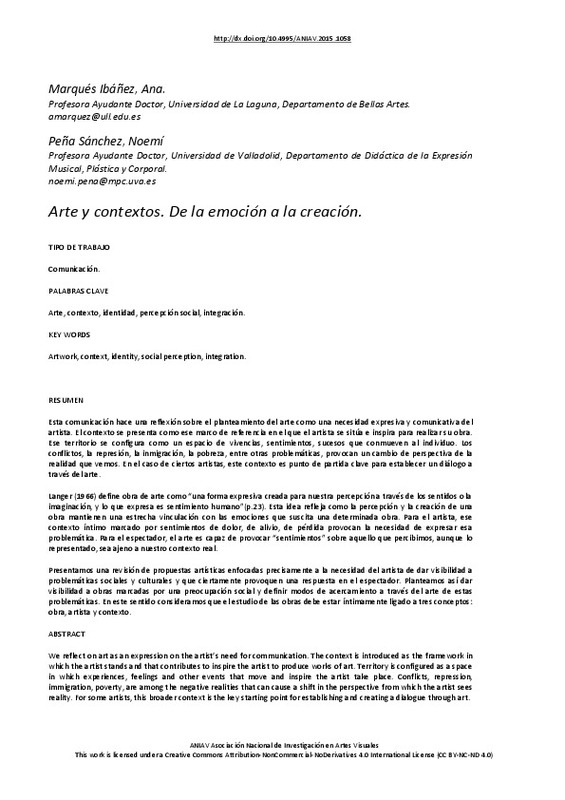|
Resumen:
|
[EN] We reflect on art as an expression on the artist’s need for communication. The context is introduced as the framework in which the artist stands and that contributes to inspire the artist to produce works of art. ...[+]
[EN] We reflect on art as an expression on the artist’s need for communication. The context is introduced as the framework in which the artist stands and that contributes to inspire the artist to produce works of art. Territory is configured as a space in which experiences, feelings and other events that move and inspire the artist take place. Conflicts, repression, immigration, poverty, are among the negative realities that can cause a shift in the perspective from which the artist sees reality. For some artists, this broader context is the key starting point for establishing and creating a dialogue through art.
Langer (1966) defines artwork as "a form of expression that communicates human feelings created for our perception through the senses or the use of imagination" (p.23). This idea reflects how perceptions and the creation of an artwork have a close connection with the emotions aroused by a particular work. For the artist, her intimate context is marked by feelings that could be for instance of pain, relief or loss and that motivate the artist to express those feelings via the work of art. For the viewer, the art is able to produce "feelings" about what we perceive, even though the object represented by the artwork might be alien or more distant to the viewer daily context or reality. We present a review of artistic proposals aimed precisely at the artist's need to give visibility to social and cultural issues that are able to arouse a response in the viewer. In this way, we propose to give visibility to works marked by a social concern. These are also works of art that suggest ways for the viewer to get closer to these social concerns. In this regard we believe that the study of these artworks must be undertaken simultaneously considering three closely linked concepts: work, artist and context.
[-]
[ES] Esta comunicación hace una reflexión sobre el planteamiento del arte como una necesidad expresiva y comunicativa del artista. El contexto se presenta como ese marco de referencia en el que el artista se sitúa e inspira ...[+]
[ES] Esta comunicación hace una reflexión sobre el planteamiento del arte como una necesidad expresiva y comunicativa del artista. El contexto se presenta como ese marco de referencia en el que el artista se sitúa e inspira para realizar su obra. Ese territorio se configura como un espacio de vivencias, sentimientos, sucesos que conmueven al individuo. Los conflictos, la represión, la inmigración, la pobreza, entre otras problemáticas, provocan un cambio de perspectiva de la realidad que vemos. En el caso de ciertos artistas, este contexto es punto de partida clave para establecer un diálogo a través del arte. Langer (1966) define obra de arte como “una forma expresiva creada para nuestra percepción a través de los sentidos o la imaginación, y lo que expresa es sentimiento humano”(p.23). Esta idea refleja como la percepción y la creación de una obra mantienen una estrecha vinculación con las emociones que suscita una determinada obra. Para el artista, ese contexto íntimo marcado por sentimientos de dolor, de alivio, de pérdida provocan la necesidad de expresar esa problemática. Para el espectador, el arte es capaz de provocar “sentimientos” sobre aquello que percibimos, aunque lo representado, sea ajeno a nuestro contexto real.Presentamos una revisión de propuestas artísticas enfocadas precisamente a la necesidad del artista de dar visibilidad a problemáticas sociales y culturales y que ciertamente provoquen una respuesta en el espectador. Planteamos así dar visibilidad a obras marcadas por una preocupación social y definir modos de acercamiento a través del arte de estas problemáticas. En este sentido consideramos que el estudio de las obras debe estar íntimamente ligado a tres conceptos: obra, artista y contexto.
[-]
|








